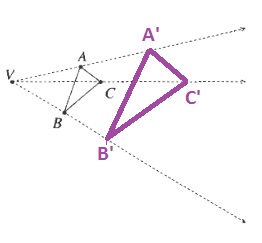All Solutions
Page 476: Closure Activity
$$
dfrac{b}{2}=14cos{75text{textdegree}}approx 3.6Rightarrow bapprox 7.2
$$
$$
h=14sin{75text{textdegree}}approx 13.5
$$
The area of a triangles is the product of the base and the height divided by 2:
$$
dfrac{7.2cdot 13.5}{2}=48.6
$$
Since the dodecagon is made up out of 12 triangles, the area of the dodecagon is:
$$
12cdot 48.6=583.2cm^2
$$
$$
A=pi 9^2=81pi approx 254.5cm^2
$$
The area of the purple surface is then:
$$
583.2-254.5=328.7cm^2
$$
Thus we note that the purple surface has more area.
$$
C_G=2pi r=2pi (30)=60pi approx 188m
$$
$$
C_D=2pi R=2pi (33)=66pi approx 207m
$$
The total distance that they both have to run is then:
$$
G: 188m+100m+100m=388m
$$
$$
D: 207m+100m+100m=407m
$$
The difference is then:
$$
407m-388m=19m
$$
Thus Devin has to run 19m more.
$$
(12-2)cdot 180text{textdegree}=1800text{textdegree}
$$
b. Since the total polygon is 360$text{textdegree}$:
$$
dfrac{360text{textdegree}}{35text{textdegree}}approx 10.28
$$
Thus is not possible because the number of sides of a polygon should be an integer.
c. The sum of all interior angles of a polygon is $(n-2)cdot 180text{textdegree}$.
$$
(n-2)cdot 180text{textdegree}=900text{textdegree}
$$
Divide both sides of the equation by 180$text{textdegree}$:
$$
n-2=5
$$
Add 2 to both sides of the equation:
$$
n=7
$$
Thus the polygon has 7 sides.
$$
180text{textdegree}-15text{textdegree}=165text{textdegree}
$$
The central angle is then also supplementary to the interior angle (because the sum of all angle in a triangle is 180$text{textdegree}$ and the triangle contains twice half the interior angle):
$$
x=180text{textdegree}-165text{textdegree}=15text{textdegree}
$$
Thus the central angle is 15$text{textdegree}$.
e. The meausre of an exterior angle is:
$$
dfrac{360text{textdegree}}{n}=dfrac{360text{textdegree}}{10}=36text{textdegree}
$$
b. Not possible
c. 7 sides
d. 15$text{textdegree}$
e. 36$text{textdegree}$
overline{AB}cong overline{AD}(text{Given})
$$
$$
overline{BC}cong overline{DC}(text{Given})
$$
$$
overline{AC}cong overline{AC}(text{Same side})
$$
$$
Downarrow SSS
$$
$$
triangle ABD cong triangle ADC
$$
$$
Downarrow
$$
$$
angle ECBcong angle ECD
$$
$$
overline{ED}cong overline{ED}(text{Same side})
$$
$$
overline{BC}cong overline{DC}(text{Given})
$$
$$
Downarrow SAS
$$
$$
triangle BCEcong triangle DCE
$$
$$
Downarrow
$$
$$
angle BECcong angle DEC
$$
$$
Downarrow
$$
$$
mangle BEC =mangle DEC=90text{textdegree} (text{ Supplementary angles})
$$
$$
Downarrow
$$
$$
overline{AC}perp overline{BD}
$$

c. The new area is the product of the previous area and the dilation factor squared:
$$
AREA=19cdot 2^2=76cm^2
$$
The new perimeter is the product of the previous perimeter and the dilation factor:
$$
PERIMETER=15cdot 2=30cm
$$
Area 76 cm$^2$
Perimeter 30 cm
$$
x=8cm
$$
$$
cos{29text{textdegree}}=dfrac{27}{x}
$$
Multiply both sides of the equation by $x$:
$$
xcos 29text{textdegree} =27
$$
Divide both sides by the cosine:
$$
x=frac{27}{cos (29text{textdegree})}approx 30.9
$$
$$
x=sqrt{16^2-5^2}=sqrt{231}approx 15.2”
$$
$$
tan{58text{textdegree}}=dfrac{6}{x}
$$
Multiply both sides of the equation by $x$:
$$
xtan{58text{textdegree}}=6
$$
Divide both sides of the equation by $tan{58text{textdegree}}$:
$$
x=dfrac{6}{tan{58text{textdegree}}}approx 3.75
$$
$$
x=sqrt{7^2+7^2}=sqrt{98}=7sqrt{2}approx 9.9
$$
b. 30.9 ft
c. 15.2”
d. 3.75
e. 9.9
$$
P(noPet)=dfrac{70+41+38+31+42}{1000}=dfrac{222}{1000}=0.222=22.2%
$$
b. The probability of an event happening is 100% decreased by the probability of an event not happening:
$$
P(Pet)=100%-P(noPet)=100%-22.2%=77.8%
$$
c. The probability is the number of favorable outcomes divided by the number of possible outcomes:
$$
P(under$35,000ANDdog)=dfrac{64+66}{1000}=dfrac{130}{1000}=0.13=13%
$$
d. Use the addition rule:
$$
P(under$35,000ORdog)=P(under$35,000)+P(dog)-P(under$35,000ANDdog)
$$
$$
=dfrac{64+63+9+3+70+66+59+7+3+41}{1000}+dfrac{64+66+77+83+97}{1000}-dfrac{130}{1000}
$$
$$
=dfrac{385}{1000}+dfrac{387}{1000}-dfrac{130}{1000}=dfrac{642}{1000}=0.642=64.2%
$$
e. The probability is the number of favorable outcomes divided by the number of possible outcomes:
$$
P(under$35,000ORdog)=dfrac{64+63+9+3+70+66+59+7+3+41+77+82+97}{1000}
$$
$$
=dfrac{642}{1000}=0.642=64.2%
$$
f. Use the multiplication rule:
$$
P(dogGIVENunder$35,000)=dfrac{P(under$35,000ANDdog)}{P(under$35,000)}=dfrac{130/1000}{385/1000}=dfrac{26}{77}approx 0.338=33.8%
$$
b. 77.8%
c. 13%
d. 64.2%
e. 64.2%
f. 33.8%
$$
A=dfrac{theta}{360text{textdegree}}pi r^2
$$
Thus the area of the shaded region is then:
$$
A=dfrac{320text{textdegree}}{360text{textdegree}}pi r^2=dfrac{8}{9}pi r^2
$$
The area of a circle is $A=pi r^2$.
The probability is then the area of the favorable outcomes divided by the area of the non-favorable outcomes:
$$
dfrac{8/9 pi r^2}{pi r^2}=dfrac{8}{9}approx 0.889=88.9%
$$

